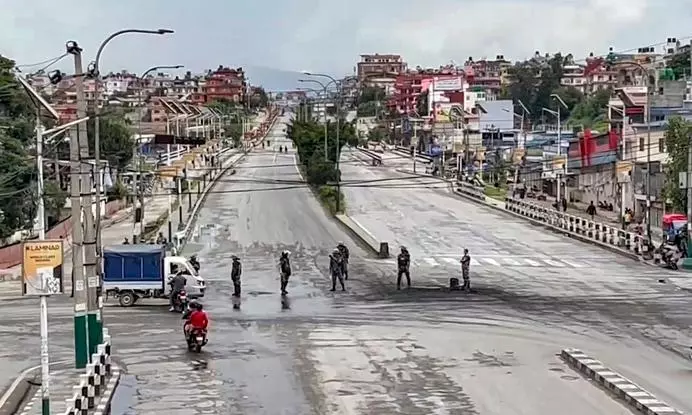
After bloody protests, Nepal crawls back to normalcy as Gen Z groups decide next PM
Kulman Ghising, an ex-managing director of Nepal Electricity Authority, is being considered as PM; prohibitory orders in place in 3 districts of Kathmandu Valley

A semblance of normalcy was observed in Nepal, which had been witnessing raging violence over the past few days, sparked by Gen Z protests, on Thursday (September 11). The army extended prohibitory orders in three districts of the Kathmandu Valley, allowing public movement during specific windows.
The death toll from the violent protests led by the 'Gen Z' group since Sunday evening has increased to 30, according to the Ministry of Health and Population. In a statement released on Wednesday evening, the ministry said 1,061 people were injured. It said 719 of the injured have been discharged, while 274 have been admitted to the hospital.
Also read: Nepal protests: Public movement allowed for few hours amid extended prohibitory orders
Who will replace Oli?
In the wake of Prime Minister KP Sharma Oli’s resignation on Tuesday, while talks are still underway on choosing his successor, reports say Gen Z groups, who have been spearheading the protests, have proposed the name of Kulman Ghising, a former managing director of Nepal Electricity Authority (NEA), for the post.
Earlier the probable prime ministerial names were of former chief justice Sushila Karki, Kathmandu Mayor Balendra Shah and Ghising. On Thursday morning, sources said, instead of Ghising, another name, Harka Sampang, mayor of Dharan Municipality, was being considered along with Karki and Shah.
Chhattisgarh CM seeks safe return of tourists
Meanwhile, Chhattisgarh Chief Minister Vishnu Deo Sai has directed officials to ensure the safe return of tourists stranded in Nepal, PTI quoted a government official as saying on Thursday.
Sai said his government has received information that some tourists from the state are currently in Nepal, according to a statement issued on Wednesday night.
“Their safety is our top priority, and instructions have been issued to concerned officials to take immediate measures to ensure their safe return,” he said.
Efforts are being made in coordination with the Centre for their safe return, Sai said.
Also read: Who is Sudan Gurung, the man who shook Nepal’s Oli government?
“Our government is fully committed to assisting every citizen in this difficult time,” he added.
On Wednesday, Prime Minister Narendra Modi had expressed his concern over the deteriorating situation in the Himalayan state, while appealing to residents there to “support peace”.
Prohibitory orders in place
The situation in Nepal remained mostly peaceful on Thursday, except for the death of three prisoners in Ramechhap district prison, as troops continued to guard the streets.
The curfew order imposed in three districts of Kathmandu valley – Kathmandu, Lalitpur, and Bhaktapur – was relieved from 6 am, a notice by Nepal Army said.
After allowing a few hours for movement to the general public to carry out essential works, the restrictive orders will be in place from 10 am to 5 pm, the notice issued by the army.
After a relaxation from 5 pm to 7 pm, night curfew will follow from 7 pm till 6 am on Friday, it added.
Also read: Why has Nepal plunged into anarchy and chaos? Local journalists share insights
People were seen rushing to the markets, shops, and grocery stores to buy essential goods as soon as the curfew was lifted. There were few vehicles on the roads, which still bore marks of the violence that had erupted since Sunday and resulted in the resignation of Oli on Tuesday.
Army’s warning against protest, arson
The curfew was imposed by the army since 5 pm on Wednesday to maintain law and order, and the Nepalese troops on Wednesday patrolled the streets to restore order and to quell possible violence “under the guise of agitation.” The army, which took control of security from Tuesday night after incidents of arson and vandalism across the country, warned that any form of demonstrations, vandalism, arson, or attacks on individuals and property would be treated as criminal acts and dealt with accordingly.
The Tribhuvan International Airport (TIA) in Kathmandu resumed services from Wednesday evening, 24 hours after closing its operations due to violent protests.
3 dead during prison break attempt
At least three inmates died during clashes with security personnel in a Nepal jail on Thursday, while more than 15,000 prisoners escaped from more than two dozen prisons across the country since the violent anti-government protests erupted in the Himalayan nation.
These latest deaths take the number of inmates who died during clashes with security forces to eight since violence erupted on Tuesday as part of the massive anti-government protests.
Also read: Trade lifeline under strain as Nepal’s crisis threatens ties with India
The confrontation began when inmates attempted to break out of the facility by causing an explosion using a gas cylinder. Security forces opened fire to regain control when three of the inmates were killed, the source said. The injured were taken to Ramechhap District Hospital, police said.
Since the violence erupted on Tuesday, more than two dozen prisons across the country witnessed clashes and breaks with mass escapes, with thousands of inmates fleeing amid arson attacks and riots, a media report said Thursday.
“The jailbreaks began when youth protesters stormed multiple prison facilities, setting administrative buildings ablaze and forcing open prison gates. By Wednesday evening, preliminary reports confirmed that over 15,000 inmates had fled from more than 25 prisons, with only a fraction returning voluntarily or being rearrested,” newspaper The Kathmandu Post said, quoting police.
In Gandaki province, the Kaski District Prison, which saw 773 escapees, jailor Rajendra Sharma said among the escapees were 13 Indian nationals and four other foreigners.

